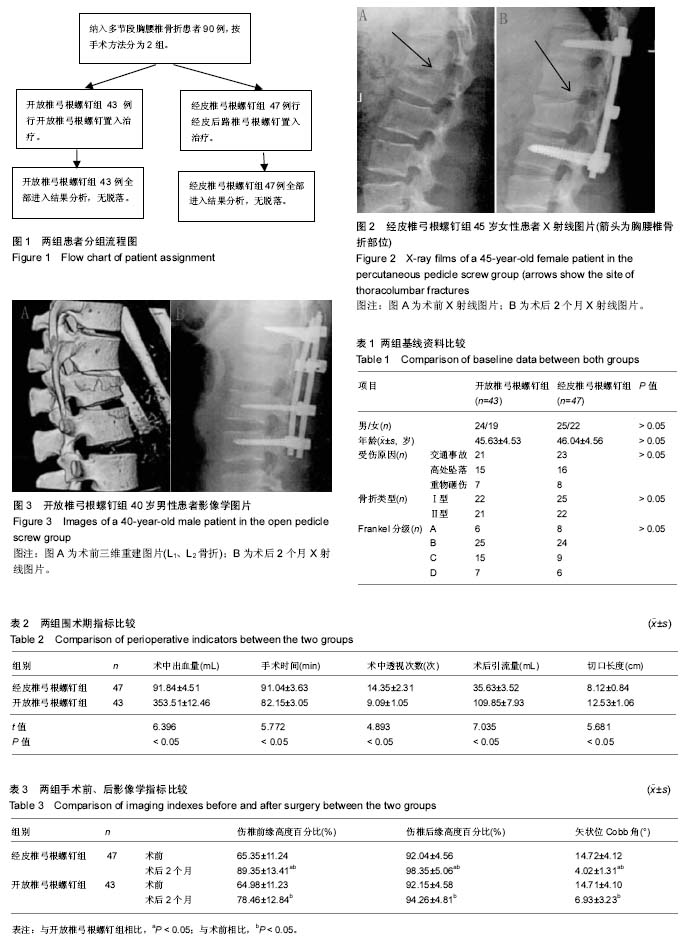| [1] 胡海刚,谭伦,林旭,等. 胸腰椎骨折复位术后椎体“空壳现象”的相关因素分析[J] .中国脊柱脊髓杂志, 2017,27(3):242-247.[2] Jaffray DC,Eisenstein SM,Balain B,et al. Early mobilisation of thoracolumbar burst fractures without neurology: a natural history observation. Bone Joint J. 2016;98-B(1):97.[3] 吴毅,何河北,孙永建,等.经伤椎置钉与跨节段椎弓根螺钉置入固定修复胸腰椎骨折的Meta分析[J].中国组织工程研究, 2015, 19(22):3604-3608.[4] 苏伟坤,叶少腾.短节段与长节段椎弓根螺钉置入修复胸腰椎骨折比较:椎体压缩率1年随访[J].中国组织工程研究, 2015,19(13): 2040-2044.[5] 文天林,孟浩,王飞,等.经皮与开放椎弓根螺钉内固定术治疗无神经损伤胸腰椎骨折的疗效对比[J].中国脊柱脊髓杂志, 2016, 26(5):401-407.[6] Pan T,Qian BP,Qiu Y. Comparison of sagittal spinopelvic alignment in patients with ankylosing spondylitis and thoracolumbar fracture. Medicine. 2016;95(4):e2585.[7] 张志成,李放,任大江,等.无神经功能障碍胸腰段屈曲牵张型损伤:经皮与开放椎弓根螺钉固定的比较研究[J].中国矫形外科杂志, 2015,23(12):1063-1067.[8] 周英杰,王许可,赵刚,等.经皮自旋转撑开椎弓根螺钉系统治疗胸腰椎骨折[J].中华创伤杂志,2015,31(5):412-417.[9] Li K, Zhang W, Liu D, et al. Pedicle screw fixation combined with intermediate screw at the fracture level for treatment of thoracolumbar fractures: A meta-analysis. Medicine. 2016; 95(33):e4574.[10] 吴培玉,黄荷.跨伤椎经皮与开放椎弓根螺钉固定治疗MagerlA型胸腰椎骨折的疗效[J].实用医学杂志,2017,33(8):1281-1285.[11] 刘琦,林志雄,黎文,等.经椎旁肌间隙与微创经皮入路手术治疗胸腰椎骨折的效果比较[J].广东医学,2016,37(8):1176-1179.[12] Chou PH,Ma HL,Liu CL,et al. Is removal of the implants needed after fixation of burst fractures of the thoracolumbar and lumbar spine without fusion? a retrospective evaluation of radiological and functional outcomes. Bone Joint J. 2016; 98-B(1):109.[13] 顾勇杰,赵刘军,于亮,等.后路短节段伤椎经皮椎弓根螺钉内固定治疗A3型和A4型胸腰椎骨折[J].中国脊柱脊髓杂志, 2016, 26(5):395-400.[14] 江伟,刘兵,余游,等.微创短节段经皮椎弓根螺钉结合经椎弓根注入可注射硫酸钙治疗胸腰椎骨折[J].中国矫形外科杂志, 2016, 24(2):114-118.[15] Skoch J,Zoccali C,Zaninovich O,et al. Bracing after surgical stabilization of thoracolumbar fractures: A systematic review of evidence,indications,and practices. World Neurosurg. 2016; 93:221-228.[16] 杨卫强,郭新军,蒋振刚.不同固定节段数目椎弓根螺钉在治疗单节段严重脱位胸腰椎骨折中的效果[J].广东医学, 2016,37(15): 2293-2295.[17] Deqing L, Kejian L, Teng L, et al. Does the fracture fragment at the anterior column in thoracolumbar burst fractures get enough attention? Medicine. 2017;96(6):e5936.[18] 杨卫强,郭新军,蒋振刚,等.经后路椎弓根螺钉联合伤椎内固定治疗单节段严重脱位的胸腰椎骨折的效果[J].广东医学, 2017, 38(2):234-236.[19] 刘新宇,阎峻,原所茂,等.小切口Schwab4级截骨结合经皮微创椎弓根螺钉治疗陈旧性胸腰椎骨折伴后凸畸形[J].中华创伤杂志,2017,33(3):202-207.[20] 孔祥清,孟纯阳,张卫红,等.微创经皮穿刺椎弓根内固定术治疗胸腰椎骨折的临床疗效观察[J].中国矫形外科杂志, 2015,23(8): 692-695.[21] Ökten A?,Gezercan Y,Özsoy KM,et al. Results of treatment of unstable thoracolumbar burst fractures using pedicle instrumentation with and without fracture-level screws. Acta Neurochirurgica. 2015;157(5):831-836.[22] 谭海涛,江建中,谢兆林,等.肌电图监测在极外侧入路椎间融合术联合经皮椎弓根螺钉内固定术中的应用[J].中国脊柱脊髓杂志, 2015,25(7):618-624.[23] Mahajan R,Chhabra HS. Re: Two-Year follow-up evaluation of surgical treatment for thoracolumbar fracture dislocation. Spine. 2015;40(4):273.[24] Pan T, Qian BP, Qiu Y. Comparison of sagittal spinopelvic alignment in patients with ankylosing spondylitis and thoracolumbar fracture. Medicine. 2016;95(4):e2585.[25] 戴建辉,林海滨,李星,等.显微内窥镜下经皮椎弓根螺钉微创经椎间孔入路椎间融合术的临床应用[J].中华医学杂志, 2017, 97(11):864-868.[26] Jeon CH,Lee HD,Lee YS,et al. Is it beneficial to remove the pedicle screw instrument after successful posterior fusion of thoracolumbar burst fractures? Spine. 2015;40(11):627-633.[27] 陈飞,王家文,马杰,等.后路短节段椎弓根螺钉固定联合伤椎置钉治疗胸腰椎爆裂性骨折效果观察[J].山东医药, 2017,57(14): 96-98.[28] Hwee Weng DH,Jun HT,Chuen ST,et al. Subsequent vertebral fractures post cement augmentation of the thoracolumbar spine: does it correlate with level-specific bone mineral density scores? Spine. 2015;40(24):1903.[29] Ökten A?, Gezercan Y, Özsoy KM, et al. Results of treatment of unstable thoracolumbar burst fractures using pedicle instrumentation with and without fracture-level screws. Acta Neurochirurgica. 2015;157(5):831-836.[30] 高速,葛胜辉,权正学,等.经伤椎椎弓根螺钉内固定联合椎体成形术治疗重度胸腰椎骨质疏松性椎体压缩骨折[J].中华创伤杂志, 2016,32(9):777-782. |



